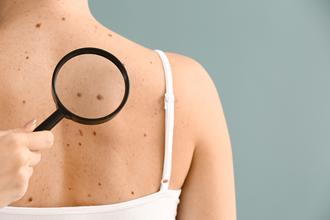
Educating the public on skin cancer is incredibly important. After all, you’re the one that looks at your skin every day, so you should know how to spot early warning signs of skin cancer. While there are certain risk factors that can increase your risk for melanoma and non-melanoma skin cancers, it’s important for everyone to visit a dermatologist once a year for a comprehensive skin cancer screening. In the meantime, here’s what to look out for.
What is an irregular or atypical mole?
Medically referred to as dysplastic nevi, these irregular moles are benign but having them could put you at an increased risk for developing melanoma over your lifetime. These moles can develop anywhere on the body but are most often found on sun-exposed areas of the skin. Since these moles vary greatly in appearance it’s important to monitor your moles regularly so you can recognize when unusual changes are occurring and call your dermatologist.
What does an irregular mole look like?
The American Academy of Dermatology (AAD) offers a simple ABCDE guideline to follow to be able to spot unusual or suspicious changes in a mole. Here’s what the ABCDEs stand for:
Asymmetry: when the halves of the moles don’t match each other in shape or appearance this could be a sign of a cancerous mole
Border: a jagged, irregular, or scalloped border can be a sign of melanoma
Color: if a mole has multiple colors or changes color this is also a warning sign not to ignore
Diameter: melanoma is often larger than 6mm (the size of a pencil eraser), even though they can be smaller
Evolving: healthy moles stay relatively the same over the years so if your mole bleeds, crusts over, itches, or changes appearance you should schedule an appointment with your dermatologist
When should I see a dermatologist?
If you have any concerns about a mole don’t hesitate to call your dermatologist to have it checked out. The sooner melanoma and non-melanoma skin cancers are detected and removed the better. Of course, everyone can benefit from visiting a dermatologist at least once a year for a comprehensive skin cancer screening. You should also be performing self-exams once a month to keep track of your moles.
If you have an irregular mole or a mole that’s changing in appearance, it’s best to play it safe and schedule an evaluation with a dermatologist who can examine the mole to make sure it hasn’t turned cancerous.
